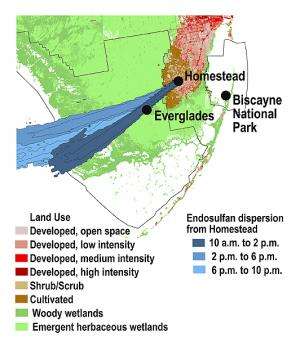The pathways of a shape-shifting pesticide

The pesticide endosulfan is being phased out in the United States because of its threat to humans and wildlife. But researchers still want to understand how endosulfan moves through the atmosphere after it has been applied to crops. Endosulfan is used against a range of insects and mites.
So Agricultural Research Service chemist Cathleen Hapeman led a 5-year study that looked at the pesticide's journey out of Florida's Homestead agricultural region. Hapeman works at the ARS Environmental Management and Byproduct Utilization Laboratory (EMBUL) in Beltsville, Maryland. EMBUL chemists Laura McConnell, Walter Schmidt, and Clifford Rice collaborated with Hapeman, along with ARS chemist Thomas Potter, who works in Tifton, Georgia.
The team established air-sampling sites in Homestead, Everglades National Park, and Biscayne National Park. The Everglades sampling site was 6 miles away from the Homestead sampling site, and the Biscayne sampling site was 12-1/2 miles away from the Homestead site.
The researchers analyzed air samples that had been collected between 2001 and 2006 and found frequent periods characterized by significant concentrations of endosulfan in the atmosphere. Samples from all three sites were dominated by gaseous concentrations of alpha-endosulfan, the pesticide's more volatile form. Average atmospheric concentrations of alpha-endosulfan in the Homestead samples were 10 times greater than levels in the Everglades samples and 100 times greater than levels in the Biscayne samples.
Atmospheric concentrations of alpha-endosulfan and beta-endosulfan in Homestead and the Everglades were significantly higher between October and May, when pesticide applications peaked to protect the growing crops. But concentrations in the Biscayne air samples did not show as much seasonal fluctuation.
Hapeman's group used meteorological conditions to model endosulfan's atmospheric transport from Homestead. Then they compared real-time measurements of endosulfan in the Everglades and Biscayne to the model's track of the endosulfan "plume" away from Homestead under matching meteorological conditions.
The scientists observed that endosulfan levels in samples collected in the two wilderness areas rose when the model indicated that the pesticide plume had entered the sampling zones. This confirmed that when conditions are right, atmospheric levels of endosulfans can increase by drift as well as by volatilization—information that can be used to help determine the fate of the pesticide in the environment.
The scientists also made new findings about alpha-endosulfan and beta-endosulfan, which are mixed and applied to crop fields at a 7:3 ratio. Both forms have the same chemical composition, but their geometry at the molecular level is different. Results from previous studies had suggested that beta-endosulfan degraded fairly easily, since it was usually found at such low levels in the environment.
But Hapeman's group found the molecular geometry of beta-endosulfan could easily change into the molecular geometry of alpha-endosulfan—a process called "isomerization"—which explains why beta-endosulfan was detected much less frequently during atmospheric sampling. Alpha-endosulfan volatilizes more easily than beta-endosulfan, which in turns facilitates its atmospheric transport far away from its point of origin.
"This gives us a clearer picture of how both compounds have actually moved through the environment when they've been used in crop management," says Hapeman.
The scientists published their findings in a 2012 issue of Atmospheric Environment.
More information: www.ars.usda.gov/is/AR/archive/sep13/
Journal information: Atmospheric Environment
Provided by Agricultural Research Service
















